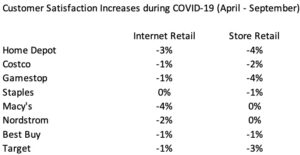The COVID-19 pandemic stressed everyone in 2020. Many of our clients had prepared their digital businesses ahead of time and survived. Other companies who were late to creating digital customer experiences suffered as people stayed away from traditional stores and shopped online. But even the best companies struggled to keep customer satisfaction levels high during 2020. The American Customer Satisfaction Index’s recent COVID-19 special retail study showed satisfaction declines across 75% of the retail companies.
Some might think that online stores would have done better than brick and mortar stores during the pandemic. But the ASCI study showed a decline of almost 5% in customer sat for internet retailers versus just a 1.3% decline for Department & Discount stores.
“Among internet retailers, no companies improve customer satisfaction during the pandemic, as the category tumbles nearly 5% overall.”
We know from past work that digital transformation has been a big factor in increasing customer satisfaction over the years. See Report: Digital Transformation Is Key To Boosting Customer Satisfaction.
So what went wrong in this pandemic?
The largest online retailer – Amazon – had a 7% decline in satisfaction. According to the ACSI data, Amazon had troubles with site performance, merchandise variety, inventory, customer support, and shipping.
What about companies that had both strong internet and store channels?
Except for Macy’s and Nordstroms, all other brands did better (or less bad) on the internet channel versus the store channel. Why? There could be lots of reasons, such as some stores being closed, most operated with restricted hours or restricted number of guests, or other COVID-19 restrictions that didn’t affect the online channel.
For many of these brands, balancing store versus online inventory must have been a big challenge. Imagine having fully stocked stores that were closed and could not supply the needed inventory to online channels.
In online stores, many brands weren’t prepared for the sudden increase in traffic, orders, and fulfillment. Over the course of 2020, many of these brands were able to improve online operations, but of course, first impressions can be lasting.
This customer satisfaction data highlights the need to get digital transformation right. While customer satisfaction took a downturn for the online channel during the COVID-19 pandemic, many brands that operated both online and stores saw the store’s customer satisfaction score drop more. Digital transformation isn’t just having an online store. Digital transformation includes digitization throughout the organization to better handle these types of market disruptions.


